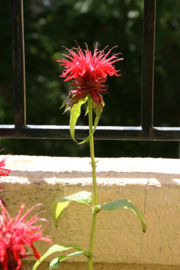Monarda: Difference between revisions
Jump to navigation
Jump to search
No edit summary |
|||
| Line 1: | Line 1: | ||
__NOTOC__{{Plantbox | __NOTOC__{{Plantbox | ||
| name = ''Monarda didyma'' | | name = ''Monarda didyma'' | ||
| common_names = bee balm | | common_names = bee balm, oswego tea, horsemint | ||
| growth_habit = herbaceous | | growth_habit = herbaceous | ||
| high = 1m <!--- 1m (3 ft) --> | | high = 1m <!--- 1m (3 ft) --> | ||
| wide = 20cm <!--- 65cm (25 inches) --> | | wide = 20cm <!--- 65cm (25 inches) --> | ||
| origin = <!--- Mexico, S America, S Europe, garden, etc --> | | origin = <!--- Mexico, S America, S Europe, garden, etc --> | ||
| poisonous = <!--- indicate parts of plants which are known/thought to be poisonous --> | | poisonous = <!--- indicate parts of plants which are known/thought to be poisonous --> | ||
| lifespan = | | lifespan = perennial{{SSN}} | ||
| exposure = | | exposure = sun (light afternoon shade where hot) | ||
| water = moderate, does not like to stand in water <!--- frequent, regular, moderate, drought tolerant, let dry then soak --> | | water = moderate, does not like to stand in water <!--- frequent, regular, moderate, drought tolerant, let dry then soak --> | ||
| features = fragrant <!--- flowers, fragrance, fruit, naturalizes, invasive --> | | features = fragrant <!--- flowers, fragrance, fruit, naturalizes, invasive --> | ||
| Line 14: | Line 14: | ||
| bloom = <!--- seasons which the plant blooms, if it is grown for its flowers --> | | bloom = <!--- seasons which the plant blooms, if it is grown for its flowers --> | ||
| usda_zones = <!--- eg. 8-11 --> | | usda_zones = <!--- eg. 8-11 --> | ||
| sunset_zones = | | sunset_zones = 2-11, 14-17, 30-41 | ||
| color = IndianRed | | color = IndianRed | ||
| image = Monarda-didyma.JPG <!--- Freesia.jpg --> | | image = Monarda-didyma.JPG <!--- Freesia.jpg --> | ||
| image_width = 180px <!--- leave as 240px if horizontal orientation photo, or change to 180px if vertical --> | | image_width = 180px <!--- leave as 240px if horizontal orientation photo, or change to 180px if vertical --> | ||
| image_caption = Monarda didyma <!--- eg. Cultivated freesias --> | | image_caption = Monarda didyma <!--- eg. Cultivated freesias --> | ||
| regnum = Plantae | | regnum = Plantae | ||
| divisio = Magnoliophyta | | divisio = Magnoliophyta | ||
| classis = Magnoliopsida | | classis = Magnoliopsida | ||
| ordo = Lamiales | | ordo = Lamiales | ||
| familia = Lamiaceae | | familia = Lamiaceae | ||
| genus = Monarda | | genus = Monarda | ||
| species = | | species = didyma | ||
}} | }} | ||
This plant provides flavor and scent with its leaves and flowers. The Earl Grey tea is scented with this plant. | This plant provides flavor and scent with its leaves and flowers. The Earl Grey tea is scented with this plant. | ||
Revision as of 04:47, 26 June 2009
Monarda didyma {{{latin_name}}}
|
bee balm, oswego tea, horsemint
| ||||||||||||||||||||||||||||||||||||||||
|---|---|---|---|---|---|---|---|---|---|---|---|---|---|---|---|---|---|---|---|---|---|---|---|---|---|---|---|---|---|---|---|---|---|---|---|---|---|---|---|---|---|

|
|
| |||||||||||||||||||||||||||||||||||||||
| |||||||||||||||||||||||||||||||||||||||||
This plant provides flavor and scent with its leaves and flowers. The Earl Grey tea is scented with this plant.
Cultivation
| calendar? | ||
|---|---|---|
| January: | ||
| February: | ||
| March: | ||
| April: | ||
| May: | ||
| June: | ||
| July: | ||
| August: | ||
| September: | ||
| October: | ||
| November: | ||
| December: | ||
| Notes: | ||
- Do you have cultivation info on this plant? Edit this section!
Propagation
- Do you have propagation info on this plant? Edit this section!
Pests and diseases
Very sensitive to mold. Do not overwater.
Species
Gallery
If you have a photo of this plant, please upload it! Plus, there may be other photos available for you to add.
-
photo 1
-
photo 2
-
photo 3
References
External links
- w:Monarda. Some of the material on this page may be from Wikipedia, under the Creative Commons license.
- Monarda QR Code (Size 50, 100, 200, 500)
